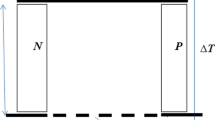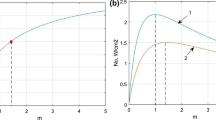Abstract
Thermoelectric power generation systems operate by converting temperature differences directly into electricity. Such systems usually contain a heat source, a thermoelectric generation module (TEG), a heat sink, thermal interface materials, and an electrical load. The equations describing the heat flow and power generation at the electric load are coupled thermoelectric equations that mix the electrical and thermal resistances of different parts of the system. The conditions of maximum power generation require careful analysis of electrical and thermal load matching. We examine the applicability of commonly used electrical load matching conditions (Duham et al. Adv. Heat Transfer 51:299, 2019, Baranowski et al. 115: 126102, 2014, Apertet et al. 97: 28001, 2012, Yazawa and Shakouri 111: 024509, 2012, Moser et al.: 41: 1653, 2012, McCarty 42:1504, 2013, Gomez et al. 113: 174908, 2013, Freunek et al. 38: 1214, 2009, Shakouri (Proceedings of the IEEE, (2006), Angrist (Direct energy conversion 1976)) (1)\(R_{load}=R_{el,TEG}\), (2)\(R_{load} =R_{el,TEG} \sqrt{1+Z T_{avg}}\) and thermal load matching condition (3)\(R_{th,TEG}=R_{th,external}\sqrt{1+Z T_{avg}}\). We find condition (1) is only applicable to the case when the thermal resistances external to the TEG are negligible. For most common applications, the external thermal resistances of the heat source and heat sink are fixed, and the goal is to find the matching thermal resistance of the TEG and the matching electrical load resistance that maximize the power generation. We present experimental results to demonstrate that the temperature difference across the TEG changes in the presence of an electrical load. The load matching conditions are complicated functions of the relevant parameters. In cases of practical interest, where either the heat sink or the heat source is fixed at near room temperature, we find condition (2) to be a good approximation for temperature differences up to about 100 K, but with the caveat that it is only valid when the system is thermally matched. When the system is not thermally matched, condition (2) is no longer valid. We find condition (3) to be a good approximation only for small temperature differences(<20K).











Similar content being viewed by others
References
M.T. Dunham, T.J. Hendricks, K.E. Goodson, Thermoelectric Generators: A Case Study in Multi-scale Thermal Engineering Design. Adv. Heat Transfer 51, 299 (2019)
L.L. Baranowski, G.J. Snyder, E.S. Toberer, The Misconception of Maximum Power and Power Factor in Thermoelectrics. J. Appl. Phys. 115, 126102 (2014)
Y. Apertet, H. Ouerdane, O. Glavatskaya, C. Goupil, P. Lecoeur, Optimal Working Conditions for Thermoelectric Generators with Realistic Thermal Coupling. EPL (Europhysics Letters) 97(2), 28001 (2012)
K. Yazawa, A. Shakouri, Optimization of Power and Efficiency of Thermoelectric Devices with Asymmetric Thermal Contacts. J. Appl. Phys. 111(2), 024509 (2012)
A. Moser, M. Erd, M. Kostic, K. Cobry, M. Kroener, P. Woias, Thermoelectric Energy Harvesting from Transient Ambient Temperature Gradients. J. Electron. Mater. 41(6), 1653 (2012)
R. McCarty, Thermoelectric Power Generator Design for Maximum Power: It’s All About ZT. J. Electron. Mater. 42(7), 1504 (2013)
M. Gomez, R. Reid, B. Ohara, H. Lee, Influence of Electrical Current Variance and Thermal Resistances on Optimum Working Conditions and Geometry for Thermoelectric Energy Harvesting. J. Appl. Phys. 113(17), 174908 (2013)
M. Freunek, M. Müller, T. Ungan, W. Walker, L.M. Reindl, New Physical Model for Thermoelectric Generators. J. Electron. Mater. 38(7), 1214 (2009)
A. Shakouri, Nanoscale Thermal Transport and Microrefrigerators on a Chip. Proceedings of the IEEE 94(8), 1613–1638 (2006)
S.W. Angrist, Direct Energy Conversion (1976)
H.J. Trodahl, Thermopower of the Superconducting Cuprates. Phys. Rev. B 51(9), 6175 (1995)
E.J. Sandoz-Rosado, S.J. Weinstein, R.J. Stevens, On the Thomson effect in Thermoelectric Power Devices. Int. J. Therm. Sci. 66, 1 (2013)
D.M. Rowe, Applications of Nuclear-Powered Thermoelectric Generators in Space. Appl. Energy 40(4), 241 (1991)
F.N. Huffman, J.C. Norman, Nuclear-Fueled Cardiac Pacemakers. Chest 65(6), 667 (1974)
https://www.globalte.com/products/thermoelectric-generators-tegs/overview (Accessed: 23 October 2021)
https://www.powerwatch.com/ (Accessed: 23 October 2021)
M. Haras, T. Skotnicki, Thermoelectricity for IoT-A Review. Nano Energy 54, 461 (2018)
C.C. Wang, C.I. Hung, W.H. Chen, Design of Heat Sink for Improving the Performance of Thermoelectric Generator Using Two-Stage Optimization. Energy 39(1), 236 (2012)
H. Lee, Optimal Design of Thermoelectric Devices with Dimensional Analysis. Appl. Energy 106, 79 (2013)
M. Baldry, V. Timchenko, C. Menictas, Optimal Design of a Natural Convection Heat Sink for Small Thermoelectric Cooling Modules. Appl. Therm. Eng. 160, 114062 (2019)
Harald Dillersberger, Bernd Deutschmann, Douglas Tham, A Bipolar 13 mV Self-Starting and 85% Peak Efficiency DC/DC Converter for Thermoelectric Energy Harvesting. Energies 13(20), 5501 (2020)
https://br.mouser.com/datasheet/2/1000/MATRIX_Industries_09062019_MCRY12-125Q-42DI-1634489.pdf (Accessed: 23 October 2021)
G. Nellis, S. Klein, Heat Transfer (Cambridge University Press, Sanford, UK, 2009)
K.T. Settaluri, H. Lo, R.J. Ram, Thin Thermoelectric Generator System for Body Energy Harvesting. J. Electron. Mater. 41(6), 984 (2012)
Author information
Authors and Affiliations
Corresponding author
Ethics declarations
Conflict of Interest
The authors declare that they have no conflict of interest.
Additional information
Publisher's Note
Springer Nature remains neutral with regard to jurisdictional claims in published maps and institutional affiliations.
Rights and permissions
About this article
Cite this article
Liang, H. Electrical and Thermal Load Matching of Thermoelectric Power Generation Systems. J. Electron. Mater. 51, 3950–3957 (2022). https://doi.org/10.1007/s11664-022-09645-0
Received:
Accepted:
Published:
Issue Date:
DOI: https://doi.org/10.1007/s11664-022-09645-0




